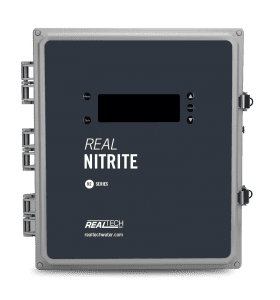In closed low-pressure water heating and cooling systems, sodium nitrite is a commonly used inhibitor that prevents oxygen related corrosion. It inhibits corrosion by promoting formation of protective films on surfaces. When nitrite is used as a corrosion inhibitor, it becomes crucial to maintain its concentration above a certain level to prevent localized corrosion from happening.
Monitoring of nitrite is most commonly done by grab sample testing. The testing is typically done using kits that rely on drop count titration methods which may require a third-party service company to visit the site.
The lack of visibility into process health due to insufficient testing frequencies can easily lead to significant damage to various components of the heating/cooling system requiring expensive maintenance and downtime as corrosion can happen very fast when inhibitor levels drop below required levels. Because these cooling and heating systems are closed loop, a decrease in nitrite concentration typically indicates problems such as bacterial action and/or leaks in the system. Both of these problems require immediate corrective action such as nitrite dose adjustments and necessary repairs to avoid exacerbation of the problem. In situations where decreasing nitrite levels are associated with bacterial action, the nitrite concentration trends can be used to adjust biocide dosing intervals and quantities. Without monitoring, biocide is dosed at a fixed schedule which can increase cost and/or not fully protect system from microbial contamination.
REAL TECH’S LOW COST NITRITE MONITORING SOLUTION
 Real Tech’s N2 Series Nitrite Analyzer is an online monitoring system that utilizes light at specific wavelengths to continuously measure nitrite levels. How much light nitrite absorbs at its peak absorption wavelength is directly proportional to its concentration. Compounds that may interfere with the measurement are compensated for using an additional reference wavelength. Benefiting from Real Tech’s innovative LED technology, accurate and stable measurements are maintained over time with minimal maintenance or operator intervention and without the use of any reagents.
Real Tech’s N2 Series Nitrite Analyzer is an online monitoring system that utilizes light at specific wavelengths to continuously measure nitrite levels. How much light nitrite absorbs at its peak absorption wavelength is directly proportional to its concentration. Compounds that may interfere with the measurement are compensated for using an additional reference wavelength. Benefiting from Real Tech’s innovative LED technology, accurate and stable measurements are maintained over time with minimal maintenance or operator intervention and without the use of any reagents.
The data from the analyzer can be conveyed to a control system through a 4-20 mA output allowing for remote monitoring of the water quality as well as automation of nitrite and biocide dosing. This way risk mitigation can easily be achieved avoiding an expensive asset management problem from occurring, corrective actions can always be taken immediately. An alternative method for monitoring nitrite is by using a P-Indicator chemical that is tied to the water’s pH. In this case, the end user just needs to make sure that the water maintains a pink colour and add more chemical when the pink colour is lost. However, this is an indirect method and as such there is a possibility that nitrite concentrations may be misrepresented and there is still need for directly testing for nitrite periodically. As a direct method, Real Tech’s nitrite analyzer provides unambiguous results that are immediately available to the end user.
The speed at which nitrite results are obtained can be vital, not only because rapid corrective action is invaluable, but also because the testing accuracy can be impacted by the handling of the water sample during the test. Test kits requiring dilution of the sample water to properly test for the high levels of nitrite typical of hot water boiler and cooling system applications may not be ideal due to accuracy issues. Moreover, test kits that rely on indicator dyes may be susceptible to light and interfering chemicals that may further impact the accuracy of the test results. Results obtained for the same water sample can vary as much as 35% when two different kits are used where one testing kit requires dilution.
Continuous monitoring allows for rapid detection of events, identify process inefficiencies, and make data-driven decisions to improve the overall efficiency of the water treatment process. Benefits of real-time monitoring include:
- EARLY EVENT DETECTION AND RAPID RESPONSE
- LOWER EXPENSIVE MAINTENANCE COSTS
- PROPER DOSE ADJUSTMENT TO SUPPORT SYSTEMS FROM BEING VULNERABLE TO UNNECESSARY DAMAGE
